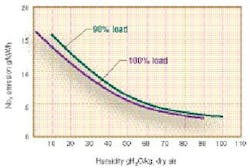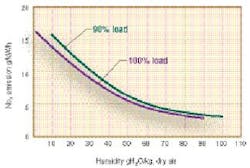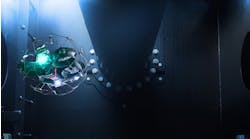Munters' diesel emission control pro-gram comprises selective catalytic reduction (SCR) and humid air motor (HAM) technologies. Havila Supply recently ordered SCR con-verters, oxidation catalysts, and integrated silencers for a newbuild offshore supply vessel. The Havila Troll, to be delivered to Havila in November 2003, will operate in the North Sea. Munters said this order is important in that it brings the system's ability to lower diesel emissions, most notably nitrogen oxides (NOx), to the attention of the offshore market.
HAM and SCR systems pre-treat and after-treat, respectively, to reduce emission levels. HAM pre-treats the combustion air before it enters the engine. SCR is applied to the engine's exhaust gases.
HAM is "a relatively new technology for reduction of NOx emissions from diesel engines," said Anders Björsell, project manager. HAM relies on using water vapor, which can readily decrease NOx emissions. When water vapor is mixed with inlet air, the thermodynamic properties of inlet air change, and the air is diluted as water vapor replaces air. The combination of dilution and the higher heat capacity of the charge air decreases NOx formation, partly due to lower heat combustion temperatures.
null
Munters says HAM test results for a Pielstick engine indicated a NOx reduction from 13.5 g/kWh to 3.5 g/kWh, or 75%, with no influence on fuel consumption or increase of carbon monoxide (CO) or hydrocarbons.
The SCR reduces NOx when a small amount of a urea/water solution is injected into the hot exhaust gas. The solution vaporizes and makes contacts with NOx in a heterogeneous catalysis over the SCR catalysts. Munters says no waste products result from the combined SCR and oxidation process. The exhaust gases consist of nitrogen, oxygen, carbon dioxide (CO2), and water vapor.
A system is installed on a RoRo vessel consuming 15,000 metric tons (mt) of fuel a year. Without the SCR, the vessel would emit 45,000 mt/yr of CO2, 1,000 mt/yr of NOx, 600 mt/yr of sulfur oxides, 100 mt/yr of CO, 50 mt/yr each of hydrocarbons and particulates. After the SCR was installed, NOx emissions dropped to 50 mt/yr, CO dropped to 30 mt/yr, and hydrocarbons dropped to 10 mt/yr.
For more information, contact Anders Björsell, Munters, Tel: +46 31 709 84 34, fax: +46 31 709 84 40, [email protected], www.munters.se.




